2009 AUDI S4 CABRIOLET warning
[x] Cancel search: warningPage 179 of 340
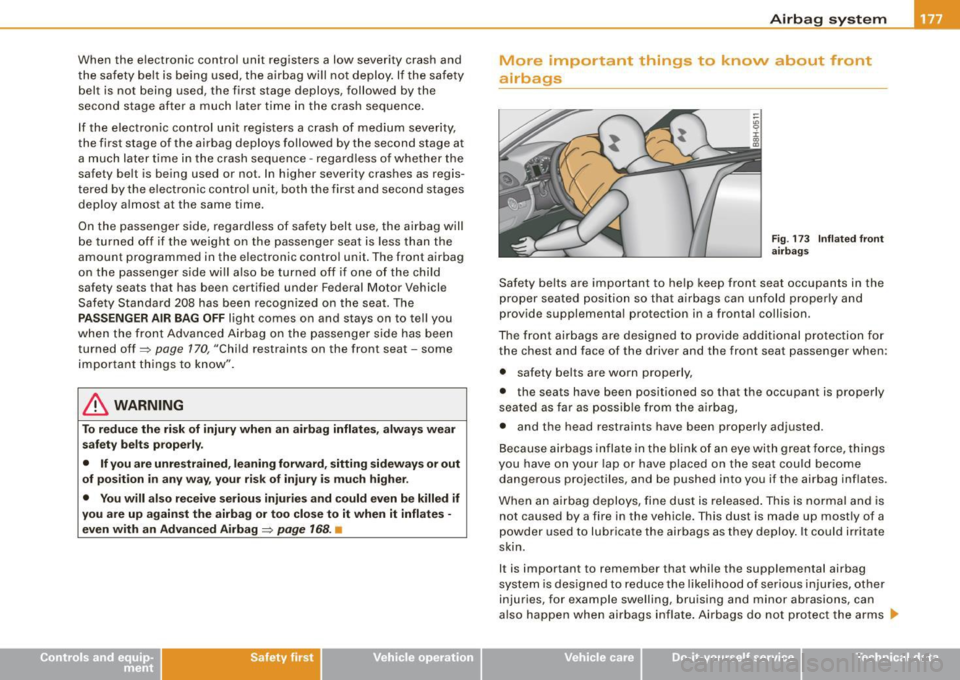
When the electronic control unit registers a low severity crash and
the safety belt is being used, the airbag will not deploy . If the safety
belt is not being used, the first stage deploys, followed by the
second stage afte r a much later time in the crash sequence.
If the electronic control unit registers a crash of medium severity,
the first stage of the airbag deploys followed by the second stage at
a much later t ime in the crash sequence -regardless o f whether the
safety belt is being used or not. In higher severity crashes as regis
tered by the e lectronic contro l unit, both the first and second stages
deploy almost at the same time.
On the passenger side, regardless of safety belt use, the airbag will
be turned off if the weight on the passenger seat is less than the
amount programmed in the e lectronic control unit . The front airbag
on the passenger s ide will a lso be turned off if one of the child
safety seats that has been certified under Federal Motor Vehicle
Safety Standard 208 has been recognized on the seat. The
PASSENGER AIR BAG OFF light comes on and stays on to tell you
whe n the front Advanced Airbag on the passenger side has been
turned off=>
page 170, "Child restraints on the front seat -some
impor tan t things to know".
& WARNING
To reduce the risk of injury when an a irbag infl ates , always wear
s afet y belts properly .
• If you are unre stra ined , leaning forward , sitting sideway s or out
of position in any w ay, your risk of in jur y i s mu ch hi gher.
• You will als o recei ve se riou s injurie s and could e ven b e killed if
you are up again st the airbag or too clo se to it when it inflate s -
even with an Advanced Airbag =>
page 168 . •
Safety first
Airb ag syst em
More important things to know about front
airbags
F ig . 173 Inflated front
airba gs
Safety belts are important to he lp keep front seat occupants in the
proper seated position so tha t airbags can unfold properly and
provide supplementa l protection in a fronta l collision.
The front airbags are designed to provide additional protection for
the chest and face of the driver and the front seat passenger when: • safety belts are worn properly,
• the seats have been positioned so that the occupant is properly
seated as far as possib le from the a irbag,
• and the head restraints have been properly adjusted.
Because a irbags inflate in the blink of an eye with great force, thi ngs
you have on your lap or have placed on the seat could become
dangerous projectiles, and be pushed into you if the airbag inflates.
When a n airbag deploy s, fine dust is released . This is normal and is
not caused by a fire in the vehicle. This dust is made up mostly of a
powder used to lubrica te the airbags as they deploy . It could irri tate
skin.
It is important to remember that while the supplemental airbag
system is designed to reduce the likelihood of serious injuries, other
injuries, for example swelling, bruising and minor abrasions, can
a lso happen when airbags infla te . Airbags do no t pro tect the arms ...
~ehicle care irechnical data
Page 180 of 340
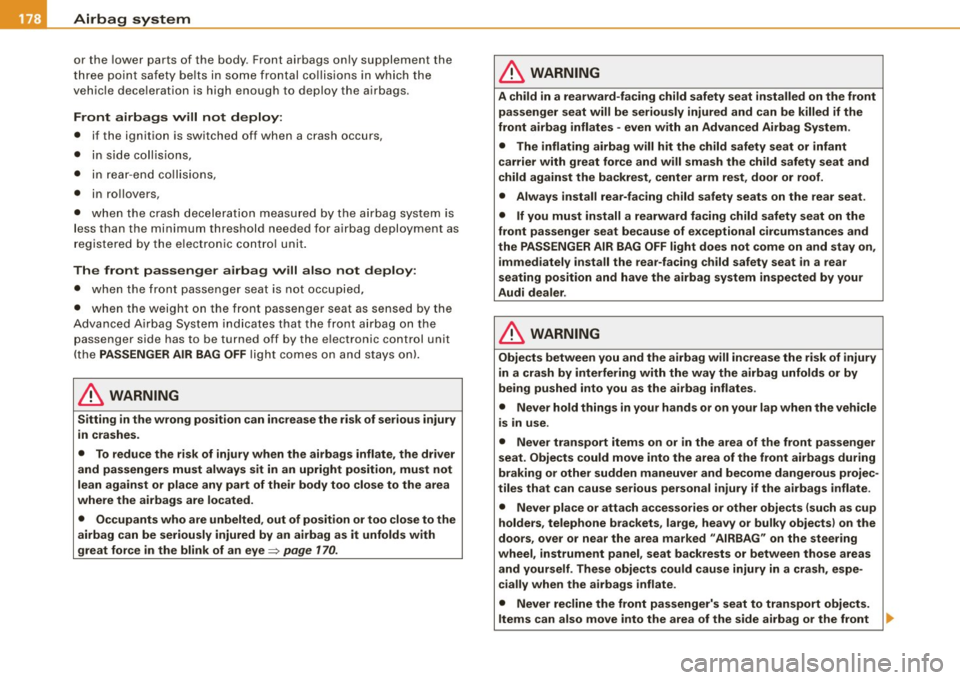
__ __::_A:::..:..:. ir..::b ~ a::. g::!...: s:::L y..::s :.::t :.::e :.:.m.:..:.... ________________________________________________ _
or the lower parts of t he body. Front airbags on ly supp lement the
th ree p oint safe ty belts in s ome front al c olli sio ns in which the
vehic le dece leration is high enou gh to deploy th e airbags .
Front airbags will not deploy:
• if the ignition is switched off when a crash occ urs,
• i n sid e coll is ions ,
• i n rea r- e nd collisi ons ,
• in rollovers,
• when th e c ras h de cele rat io n measu red by th e airba g sys tem is
l ess than the minimum threshold needed for a irbag deplo yment as
r egi stere d by t he ele ctr onic con trol unit.
The front passenger airbag will also not deploy :
• whe n t he fr ont pass enge r sea t is not occup ied,
• when the weight on the front passenger seat as sensed by the
A dvanced A ir b ag Sys te m in d ica tes th at the fr ont airba g on the
p assenge r side has to be t urned off b y the e lectronic cont rol unit
(t he
PASSENGER AIR BAG OFF ligh t com es o n an d stays o nl.
& WARNING
Sitting in the wrong posit ion can increase the risk of serious injury
in crashes .
• To reduce the risk of injury when the airbags inflate , the driver
and passengers must always sit in an upright position , must not
lean against or place any part of the ir body too close to the area
where the airbags are located.
• Occupants who are unbelted , out of posit ion or too close to the
airbag can be seriously injured by an airbag as it unfolds with
great force in the blink of an eye:::::,
page 170 .
& WARNING
A child in a rearward-facing child safety seat installed on the front
passenger seat will be seriously injured and can be killed if the
front airbag inflates - even with an Advanced Airbag System .
• The inflating airbag will hit the child safety seat or infant
carrier with great force and will smash the child safety seat and
child against the backrest , center arm rest , door or roof.
• Always install rear-facing child safety seats on the rear se at.
• If you must install a rearward facing child safety seat on the
front passenger seat because of exceptional circumstances and
the PASSENGER AIR BAG OFF light does not come on and stay on, i mmediately install the rear-facing child safety seat in a rear
seating position and have the airbag system inspected by your
Audi dealer .
& WARNING
Objects between you and the airbag will increase the risk of injury
in a crash by interfering with the way the airbag unfolds or by
being pushed into you as the airbag inflates .
• Never hold things in your hands or on your lap when the vehicle
is in use.
• Never transport items on or in the area of the front passenger
seat. Objects could move into the area of the front airbags during
braking or other sudden maneuver and become dangerous projec
tiles that can cause serious personal injury if the airbags inflate .
• Never place or attach accessories or other objects (such as cup
holders , telephone brackets , large, heavy or bulky obje cts) on the
doors , over or near the area marked "AIRBAG" on the steering
wheel, instrument panel , seat backrests or between those areas
and yourself . These objects could cause injury in a crash, espe
cially when the airbags inflate .
• Never recline the front passenger's seat to transport objects .
Items can also move into the area of the side airbag or the front ..,
Page 181 of 340

__________________________________________________ A_ i_ r _b _a...; g::- s_ y=--- s_t _e _m ___ __
& WARNING (continued )
airbag dur ing braking or in a sudden maneuver . Objects ne ar the
airbags can become proje ctiles and cau se injury , particularly when
the seat is reclined .
• Never tilt the front passenger seat backrest forward when the
vehicle is moving . An inflating airbag will force the backrest back
ward and can injure rear seat occupants.
_& WARNING
The fine dust created when airbags deploy can cause breathing problems for people with a history of asthma or other breathing
conditions.
• To reduce the risk of breathing problems, those with asthma or
other respiratory conditions should get fresh air right away by
getting out of the vehicle or opening windows or doors.
• If you are in a collis ion in which airbags deploy, wash your
hands and face with mild soap and water before eating.
• Be careful not to get the dust into your eyes , or into any cuts or
scratches .
• If the residue should get into your eyes, flush them w ith
water. •
Monitoring the Advanced Airbag
System
Airbag monitoring indicator light :~
Two sep arate in dica tors m onitor the fu ncti on of th e
Adv anced A irba g Sys tem: the airbag moni tor ing in dica to r
l ight and t he
PASSENGER AIR BAG OFF light.
The Advanc ed A ir b ag S yst em (includ ing the e lec tronic co ntro l unit,
sensor c ircuits and system wiring) is monitored continuously to
Controls and equip ment Safety first Vehicle operation make sure that it is functioning properly whenever the ignition is on
.
Eac h tim e you tu rn on t he ignit io n, th e airbag monitoring ind ica tor
light
fl wi ll come on for a few seconds (self diagnostics) .
The system must be inspected when the indicator l ight ~:
• do es not com e on when the ig nit ion is sw itch ed on,
• does not go out a few seconds after you have switched on the
i gni tion , or
• comes on while driving.
I f an a irbag s ystem malfu ncti on is detec ted , the indi cator light will
first start flash ing to catch the driver's attention and then sta y on
co nti nuou sly to serve as a constant r eminder to h ave the sys tem
inspected immediately.
If a malf unctio n occurs that t urns the front airbag on the passenger
s id e off , the PASS ENGER AIR BAG OFF light w ill come on a nd s ta y on
whenever the ig nition is on.
_& WARNING
An airbag system that is not functioning properly cannot provide
s upplemental protect ion in a frontal crash .
• If the airbag indicator light comes on , it means that there may
be something wrong with the Advanced Airbag System . It is
possible that the airbag will inflate when it is not supposed to, or
will not inflate when it should .
• Have the airbag system inspected immediately by your Audi
dealer. •
Vehicle care Do-it-yourself service Technical data
Page 183 of 340

__________________________________________________ A_ i_ r _b _a...; g::- s_ y=--- s_t _e _m ___ ffllll
the weight -sensing mat to measure more weight than is actually on
the seat .
If the PA SSENGER AIR BAG OFF light still d oes not come on and does
not stay on continuously (when the ignition is switched on),
• take the child restraint off the front passenger seat and insta ll it
properly at one of the rear seat positions. Have the airbag system
inspec ted by your Audi dea ler immediately .
• move the child to a rear seat position and make sure that the
child is proper ly restrained i n a child restraint that is appropriate for
its size and age.
The
PASSENGER AIR BAG OFF light shou ld NOT come on when the
ignition is on and an adult is sitting in a proper seating position on
the front passenger seat . If the
PASSENGER AIR BAG OF F light
comes on and stays on or flashes for about 5 seconds whi le driving,
under these circumstances, make sure that:
• the adult on the front passenger seat is properly seated on the
center of the seat cushion with his or her back up against the back
rest and the back rest is not reclined => page 148, "Pro per occupant
seating positions",
• the adult is not taking weight off the sea t by ho lding o n to the
passenger assist handle above the front passenger door or
suppo rting thei r weight on the armrest,
• the safety belt is being proper ly worn and that there is not a lot
of slack in the safety bel t webbing,
• accessory seat covers or cushions or other things that may cause
an incorrect reading or impression on the weight -sensing mat
under the upho lstery of the seat have been removed from the front
passenger seat,
• a safety belt extender has not been left in the safety be lt latch for
t he front passenger seat .
In addition to the
PASSENGER AIR BAG OFF l ight in the center of the
instr ument panel, the message
PASSENGER AIR BAG OFF or
PAS SENGER AIR BAG ON wi ll briefly appear in the instrument c luster
Controls and equip ment Safety first
Vehicle operation display. This is to inform the driver of the current front passenger
a
ir b ag status .•
Important safety instructions on monitoring
the Advanced Airbag System
& WARNING
An airbag system that is not fun ctioning properly cannot provide
supplemental protection in a frontal cra sh .
• If the airbag ind icator li ght come s on , it means that there may
be something wrong with the Advan ced Airbag System . It is
possible that the airbag will inflate when it is not suppo sed to , or
will not inflate when it should .
• Ha ve the airb ag system inspected immedi ately by your Audi
dealer.
& WARNING
If the front airbag inflate s, a child witho ut a child restraint , in a
rearward-facing child safety seat or i n a forward -fa cing child
restr aint that has not been properly installed will be seriously
injured and can be killed .
• Even though your vehicle is equipped with an Advanced Airbag
Sy stem , make certain that all children , e speci ally 12 year s and
younger , always ride on the back seat p roperly re strained for their
age and size .
• Always install forward or rear -facing child safety seat s on the
re ar s eat - even with an Ad van ced Airb ag Sy stem .
• If you mu st install a rearward -fa cing child safety seat on the
front pa ssenger seat be cau se of ex ceptional cir cum stance s and
the PASSENGER AIR BAG OFF light does not appear and stay on ,
immediately in stall the rear -facing child safety seat in a rear ...
Vehicle care Do-it-yourself service Technical data
Page 184 of 340
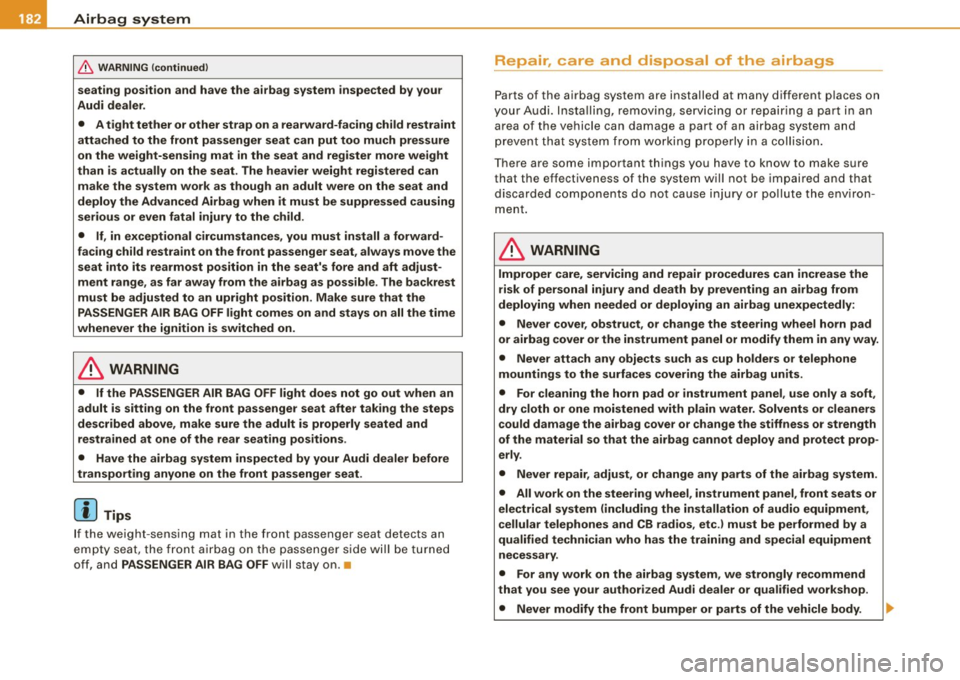
___ A_ ir_b _ a_ g~ s_ y_s _t _e _m _________________________________________________ _
& WARN IN G (c ontinu ed )
seating posit ion and ha ve the airb ag system inspected by your
Audi dealer .
• A t ight tether or other strap on a rearward-fa cing child restr aint
atta ched to the front pas senger se at can put too much pres sure
on the weight-sensing mat in the seat and reg ister more weight
than i s actually on the seat. The heavier weight registered can
make the system work as though an adult were on the seat and
deploy the Advanced Airbag when it must be suppre ssed causing
serious or even fatal injury to the child .
• If, in exc eptional cir cum stance s, you mu st in stall a forward
facing child restraint on the front passenger seat , always move the
seat into its rearmost po sition in the seat's fore and aft adjust
ment range , as far away from the airbag as possible . The ba ckrest
must be adjusted to an upright position. Make sure that the
PASSENGER AIR BAG OFF light comes on and stays on all the time
whenever the ignition is switched on .
& WARNING
• If the PASSENGER AIR BAG OFF light does not go out when an
adult is sitting on the front passenger seat after taking the steps
described above, make sure the adult i s properly seated and
restrained at one of the rear seating position s.
• Have the airbag system inspected by your Audi dealer before
transpo rting anyone on the front passenger seat .
[ i ] Tips
If the weight -sensing mat in the front passenger seat detects an
e m pty seat , the fron t airbag on the passenge r side will be tu rned
off, and PASSENGER AIR BAG OFF will stay on.•
Repair, care and disposal of the airbags
P arts of the airbag system are installed at many different p laces on
your Au di. Insta lli ng, removing, se rvic ing or repa iring a par t in an
area of the vehicle can damage a part of an airbag system and
p revent that system from w orking properly in a c ollisi on.
There are some important things you have to know to make sure
that the effectiveness of the system will not be impai red and that
discarded componen ts do no t cause injury or po llute t he e nv iro n
ment .
& WARNING
Improper care , servicing and repair procedures can increase the
risk of personal injury and death by preventing an airbag from
deploying when needed or deploying an airbag unexpectedly:
• Never cover , obstruct , or change the steering wheel horn pad
or airbag cover or the instrument panel or modify them in any way .
• Never attach any objects su ch as cup holders or telephone
mountings to the surfa ces covering the airbag units .
• For cleaning the horn pad or instrument panel , use only a soft ,
dry cloth or one moistened with plain water. Solvents or cleaner s
c ould damage the airbag cover or change the st iffness or strength
of the material so that the airbag cannot deploy and protect prop
erly .
• Never repair , adju st, or change any parts of the airbag sy stem .
• All work on the steering wheel , instrument panel, front seats or
electrical system (including the installation of audio equipment ,
cellular telephones and CB rad ios , etc .I must be performed by a
qualified technician who has the training and special equipment
necessary .
• For any work on the airbag system, we strongly recommend
that you see your author ized Audi dealer or qualified workshop .
• Never modify the front bumper or parts of the vehicle body .
Page 185 of 340

__________________________________________________ A_ i_ r _b _a...; g::- s_ y=--- s_t _e _m ___ lffllll
& WARNING (continued )
• Always make sure that the side airbag can inflate without inter
ference :
- Never install seat covers or replacement upholstery over the
front seatbacks that have not been specifically approved by
Audi.
- Never use additional seat cushions that cover the areas
where the side airbags inflate.
- Damage to the original seat covers or to the seam in the area
of the side airbag module must always be repaired immedi
ately by an authorized Audi dealer.
• The airbag system can be activated only once. After an airbag
has inflated, it must be replaced by an authorized Audi dealer or
qualified technician who has the technical information , training
and special equipment nece ssary.
• The airbag system can be deployed only once . After an airbag
has been deployed , it must be replaced with new replacement
part s designed and approved especially for your Audi model
version. Replacement of complete a irbag systems or airbag
components must be performed by qualified workshops only .
Make sure that any airbag service action is entered in your Audi
Warranty
& Maintenance booklet under AIRBAG REPLACEMENT
RECORD .
• In accidents when an airbag is deployed , the vehicle battery
s eparates the alternator and the starter from the vehicle electrical
system for safety reasons with a pyrotechnic circuit interrupter.
-Work on the pyrotechnic circuit interrupter must only be
performed by a qualified dealer -risk of an accident !
- If the vehi cle or the circuit interrupter is scrapped , all appli
cable safety precautions must be followed . •
Controls and equip ment Safety first
Vehicle operation
Other things that can affect Advanced Airbag
performance
Changing the vehicle 's suspension system can cha nge the way that
the Advanc ed Ai rbag Syste m perfor ms in a cras h. Fo r ex amp le,
u sing tire -rim combinations not a pproved by Audi, lowering the
ve hicle , c hang ing the st iffness o f the suspe nsion, inclu din g the
spr ings, s uspension struts, shock absorbers etc. can change the
fo rc es that ar e meas ured by th e a irbag sens ors and sent to the e lec
tronic control un it. Some suspens ion changes can, for example,
in crea se th e fo rc e leve ls meas ured by th e se nsors and ma ke t he
airbag system dep loy in crash es in wh ich it wou ld not dep loy if the
c h anges had no t been m ade . Ot her k in ds of cha nge s m ay red uce
the fo rce levels measured by the sensors and p revent t he airba g
fr om depl oyin g whe n it should.
T he sensors in the safe ty b elt b uckle fo r the driver a nd front
passenger seat te ll the electronic control module if the safety belt is
l a tc h e d or not. If the s afe ty be lt is bei ng use d, t he fr ont ai rbag w ill
dep loy at a s lightly higher rate of vehic le dece leration than if the
sa fe ty belt is not be ing used . T here for e, in a partic ular co lli sion , it is
possible t hat an airbag will not dep loy at a seating position w here
the safe ty belt is b ein g us ed b ut will infl ate a t th e po siti on w here the
safety belt is not being used. It is important that nothi ng interfere
with the safety belt b uck les so that the sensors can send the correct
i nformat ion about safety b elt use to the electronic control un it.
& WARNING
Changing the vehicle's suspension including use of unapproved
tire -rim combinations can change Advanced Airbag performance
and increase the risk of serious personal injury in a crash.
• Never install suspension components that do not have the
same performance characteristics as the components originally
installed on your vehicle .
• Never use tire-r im combinations that have not been approved
by Audi. .,.
Vehicle care Do-it-yourself service Technical data
Page 186 of 340
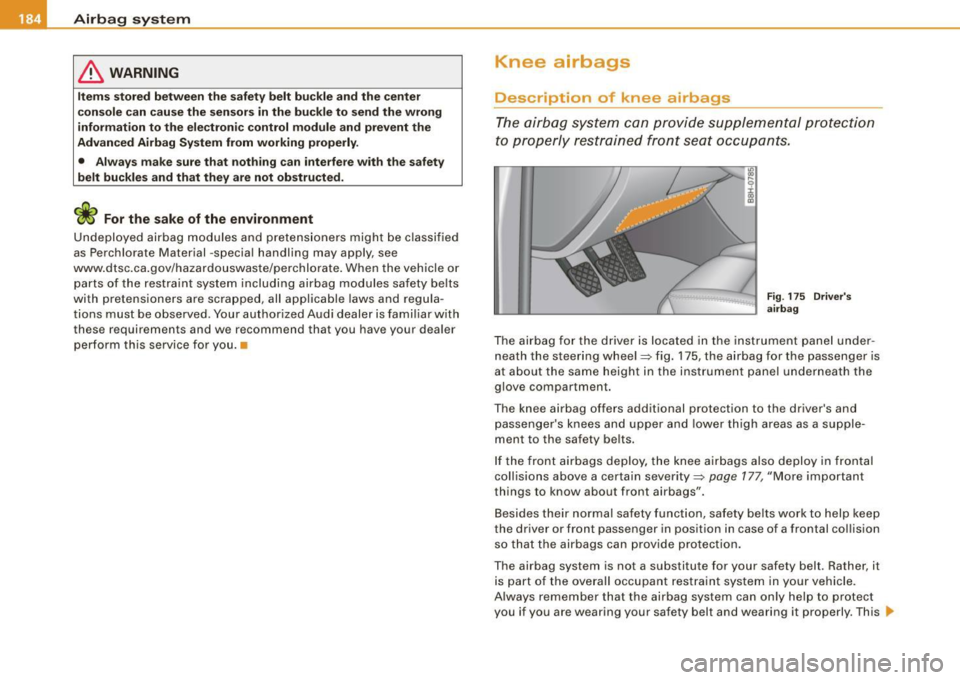
___ A_ ir_b _a_ g:-- s-=- y_s _t _e _m _________________________________________________ _
& WARNING
Item s s to red betwe en th e safe ty belt b uckle a nd th e cente r
co nso le can c au se the sen sors in the buc kle to send the wro ng
inf orm ation t o the e lec tronic c ontrol m odule and pre vent th e
Adv anced Airb ag System fr om working pr operly .
• Always make su re that n oth ing ca n int erfere with the saf ety
belt buckle s and that they ar e not ob structed.
<£> For the sake of the environment
Undeployed airbag modules and pretensioners might be c lassified
as Perchlorate Material -specia l handling may apply, see
www .dtsc.ca .gov/hazardouswaste/perchlorate. When the vehicle o r
parts of the restraint system including airbag modules safety be lts
with pretensioners are scrapped, all applicable laws and regula
tions must be observed . Your author ized Audi dealer is fami liar with
these requirements and we recommend that you have your dea ler
perform th is service for you. •
Knee airbags
Description of knee airbags
The airbag system can pr ovide supplemental protection
t o properly restrained fron t se at occu pants.
Fi g. 175 Dr iver's
ai rba g
The airbag for the driver is located in the instrument panel under
neath the steering wheel=> fig. 175, the airbag for the passenger is
at about the same height in the instrument panel underneath the
g love compartment.
The knee airbag offers additional protection to the driver 's and
passenger's knees and upper and lower thigh areas as a supple
ment to the safety be lts.
If the front airbags deploy, the knee airbags also deploy in frontal
coll isions above a certain severity=>
page 177, "More important
things to know about front airbags".
Besides their normal safety function, safety be lts work to help keep
the driver or front passenger in position in case of a frontal collision
so that the airbags can provide protection.
The airbag system is not a substitute for your safety belt. Rather, it is part of the overall occupant restraint system in your vehicle.
Always remember that the airbag system can only help to protect
you if you are wearing your safety belt and wearing it properly. This
~
Page 187 of 340
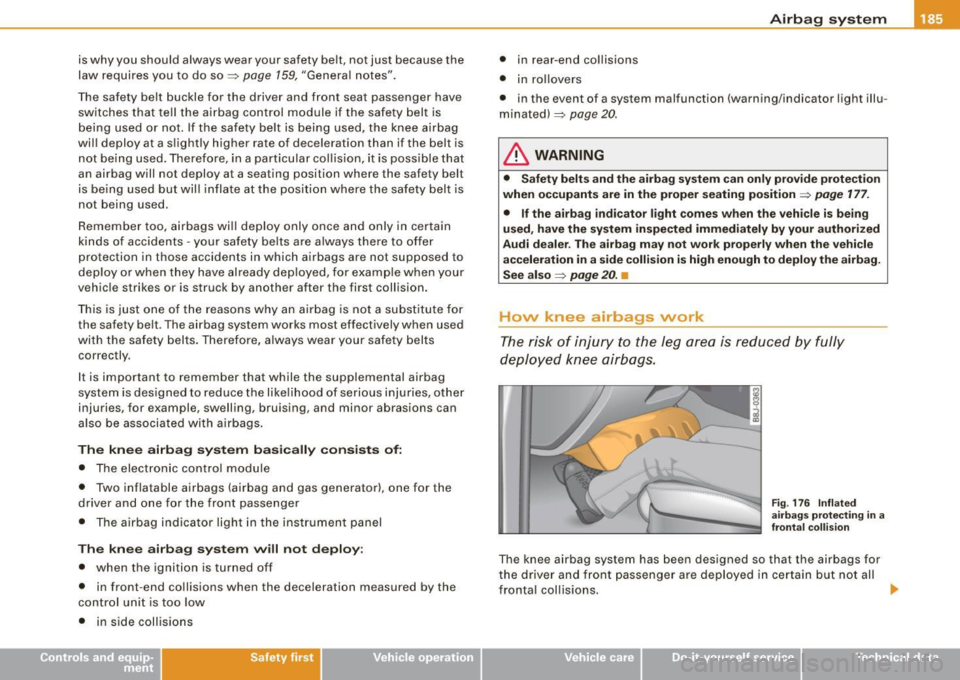
is why you should always wear your safety belt, not just because the
law requires you to do so=>
page 159, "Genera l notes".
The safety belt buckle for the driver and front seat passenger have switches that tell the airbag control module if the safety belt is
being used or not. If the safety belt is being used, the knee airbag
will deploy at a s lightly higher rate of deceleration than if the belt is
not be ing used . Therefo re, in a particular col lis ion, it is possible that
an airbag will not deploy at a seating position where the safety belt
is be ing used but will inflate at the position where the safety belt is
not being used .
Remember too, airbags will deploy only once and only in ce rtain
kinds o f accidents - your safety belts are always there to of fer
protection in those accidents in which airbags are not supposed to
deploy or when they have already dep loyed, for e xamp le when you r
vehic le strikes or is struck by another after the first collision.
This is just one o f the reasons why an ai rbag is not a substitute for
the safety be lt . The airbag system works most effectively when used
with the safety belts. Therefore, a lways wear your safety belts
correctly.
I t is important to remember that while the supplemental airbag
system is designed to reduce the likelihood o f serious in juries, other
injuries, for example, swelling, bruising, and minor abrasions can
a lso be associated with airbags.
The kn ee airbag syst em bas ically consists of:
• The electronic control module
• Two inflatable airbags (ai rbag and gas generator), one for the
driver and one for the front passenger
• The ai rbag indica tor light in the instrumen t panel
T he kn ee airbag sy stem will not deplo y:
• whe n the igniti on is turned off
• in front -end collisions when the deceleration measured by the
control unit is too low
• in s ide coll isions
Safety first
Airb ag syst em
• in rear -end collisions
• in ro llovers
• in the event of a system malfunction (warning/indicator light illu
minated)=>
page 20 .
& WARNING
• Safety belts and the airbag sy stem ca n only provide protection
when o ccupant s are in the proper seating position=>
page 177.
• If the airbag ind icator light comes when the vehi cle is being
u sed , have the system in spected immediately by your authorized
Audi dealer . The airbag may not work properly when the vehicle
acceleration in a side colli sion is high enough to deploy the airbag.
See also
=> page 20. •
How knee airbags work
The risk of injury to the l eg a re a i s re duced by fully
d eployed knee air ba gs.
Fig . 17 6 Infl ated
a irbag s protecting in a
front al colli sio n
The knee airbag system has been designed so that the airbags for
the d river and front passenger a re deployed in certain but not all
frontal collisions. ..,
~ehicle care irechnical data